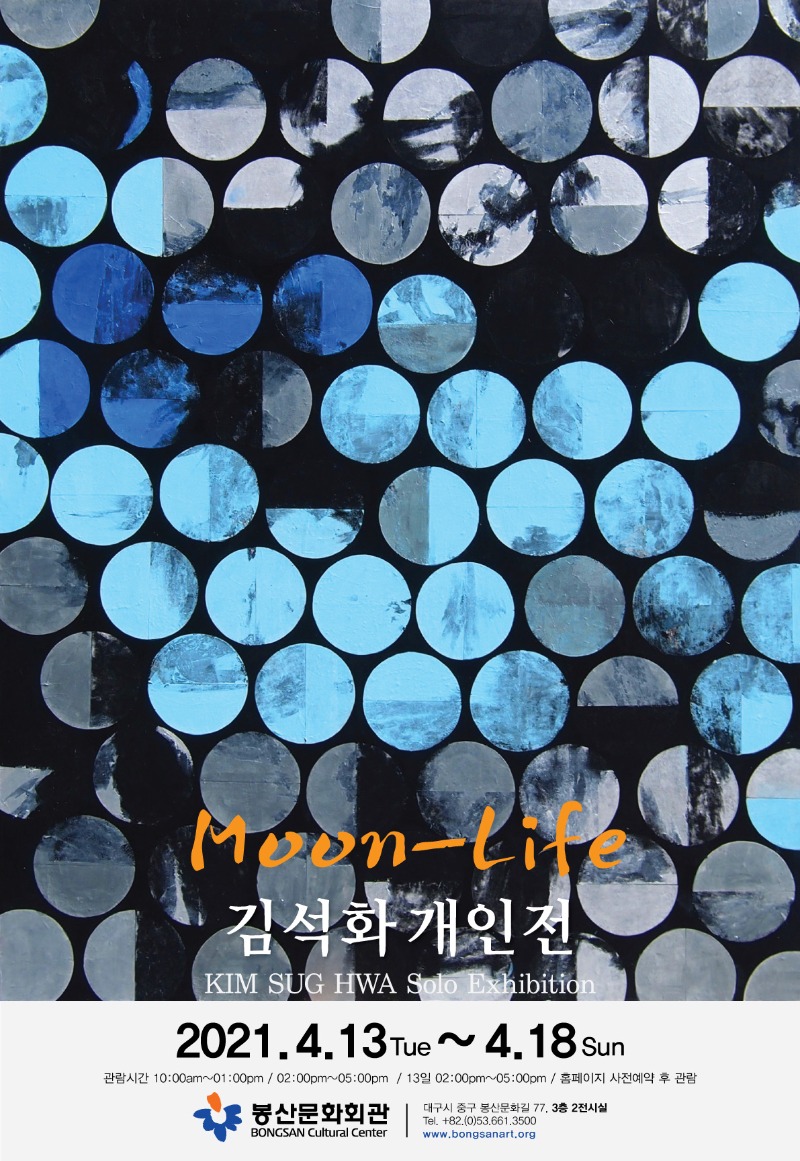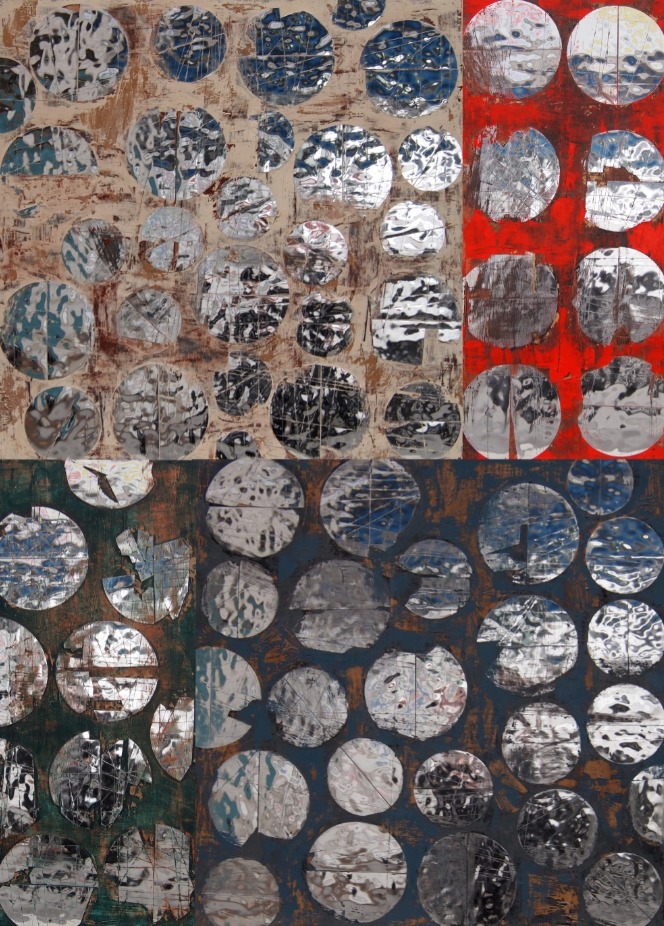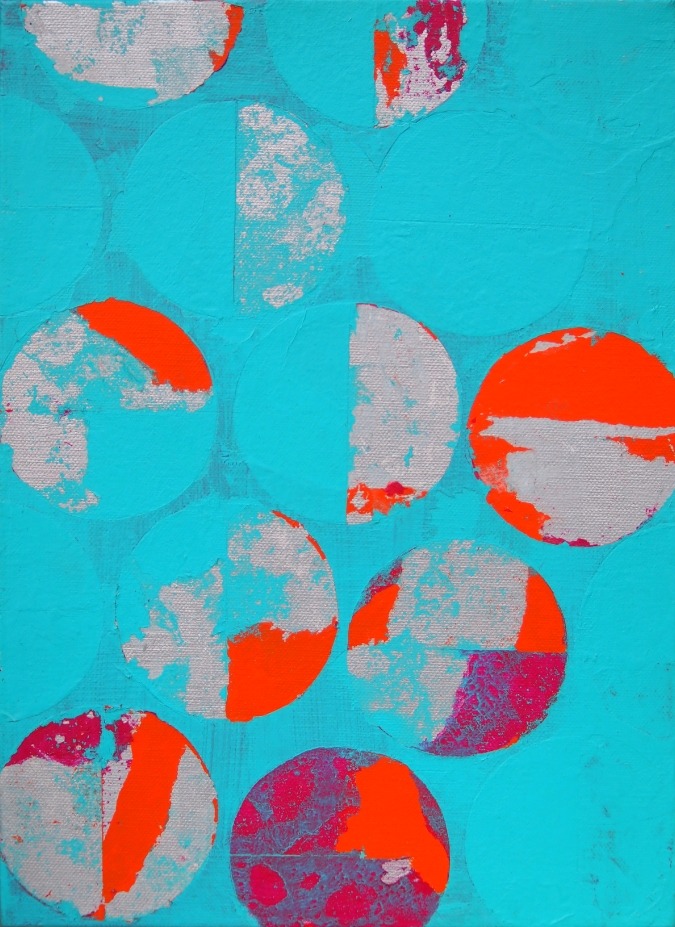
| Period| | 2021.04.13 - 2021.04.18 |
|---|---|
| Operating hours| | 10:00-13:00,14:00-17:00 * 4/13(화) 14:00-17:00 (13:00-14:00 방역, 홈페이지 사전예약 후 입장) |
| Space| | Bongsan Cultural Center |
| Address| | 77, Bongsanmunhwa-gil, Jung-gu, Daegu, Republic of Korea |
| Closed| | Monday, Lunar New Year, Chuseok |
| Price| | Free |
| Phone| | 053-661-3500 |
| Web site| | 홈페이지 바로가기 |
| Artist| |
|
정보수정요청



|
|
Exhibition Information




If could find a dream in the moon A moon drawn by artist Kim Sug Hwa is beautiful, but its beauty has gloom, pain and sadness. His drawings cling to the form of beauty with ostensibly cheerful shades and arrangements. But, if the audiences take its word for it, that attitude is so innocent. We can feel happiness when looking at the moon’s numerous appearances lined up on canvas. However, how can we enjoy that happiness by putting aside the anxiety surrounding our lives? To confess my faith in advance, I was the innocent person who tried to hold on the happy moment by using his work as a medium. After seeing his individual exhibitions that were released in 2019 and 2020, I compared his drawings to colorful M&M chocolate through my review. I also talked about a pleasant mind allude to lyric of children’s song <Moon, what kind a moon>. But the moon drawn by Kim Sug Hwa is a half-moon, not a “Round moon like a little tray”, and deep melancholy was laid underneath the layer of beauty that was outwardly revealed. The reason why I passed this fact carelessly at the first and found out later is because of my lack of knowledge. To give the excuse, two half-moon shapes were attached and it looked like a complete circle, so arguing whether it is a full moon or a half-moon may not matter. The shape of the moon that captured at some point of the artist’s life might have entered the drawing, but it is not necessary for listeners being tied to the research topic “Why is a half-moon?” unless a person whose statement is disclosed for the opportunity. To the audience, the indulgence of images is more important than this. When we see an artist’s paintings, do we have to feel happy or be buried in depression? Or do we have to accept both these feelings at the same time? Actually, doesn't it matter either way? I think this is a separate matter from the accumulation of knowledge, the legitimacy of ethics, or the choice of taste. Just a few years ago, I tried to force myself to pull out the bright side of the painting, but now I who dispelled depression can afford to look around the dark side of others. However, the third type of attitude of the consumer–about the time to feel for both happiness and melancholy-is most suitable for finding clues to understanding this exhibition <Moon-Life>. The theme word that goes through the artist's life for about a year since the last individual exhibition is “Corona Blue”. A new word which is added blue color symbolizing the depression in epidemic shows his recent works well. Though not just happy, but there is a fascinating life. Despite no one can be free for the recent environment, I got a chance to take a close look at an artist, Kim Sug Hwa And I have learned a lot that I didn't know before, he has been trying to balance work and daily life throughout his creation and exhibition. He values reading books and strolling, shares his talents and career in cultural facilities and has an identity of being a member of an artist’s family simultaneously. He has controlled the strength of his work by placing reading and strolling in front and back with drawing at the center. The idea and implement of works should have non-artistic activities at the edge of its compliance. If an art is returned to labor, a series of works that aren’t bound to be vague for the output and expected effects can also serve as a way for the artist to alienate himself. Sometimes he recognizes himself as incompetent like a broken base in Jeong Ho Seung’s poem <Broken Pieces>. Nevertheless, he is moving in a consistent direction. For a short time, a them of the moon has become a place to bloom brilliant content in his life. The moon is always in the night sky over a similar period of time and trajectory and his life is repeated like that. As everyone knows, the moon has been an art motivator for many years. Artists have expressed the moon as familiar to us in their own way. The beauty which has been observed and described in many ways provides a new spectacle with development of modern optical technology. Therefore, there are many cases where something other than art attracts as much surprise as art. Recently, in Italy, a picture of the moon taken by an astro-photographer made people surprising. Each moon on one screen has various colors. If you see that picture, you will be able to find a similar appearance as the moon in Kim Sug Hwa’s drawing. For example, craters on the moon’s surface immensely resemble the traces of brush stroke in paintings. When we think of the moon, the color categories that we perceive as close to yellow or white are caught much more diversely in observational photographs. This is because there are a difference in the degree of scattering depending on the different air quality in each region. However, when we look at the picture that is observed with telescope or the probe sent from the site, the surface of the moon is an achromatic zone. The object is fixed, but the color depends on the conditions that illuminate it. Doesn’t it stand to reason that waxing and waning of the moon created by Earth’s shadow? There is no difference in the particles of paints covering the canvas screen. For example, if simply think of it, a blue print molecule grain would color as blue. But the color of the molecules observed with microscope is close to gray. The object we observe with our eyes does not contain the properties of the color. It has differences in arrangement to make it appear different colors in our eyes and cerebrum. According to the scientific principles identified by the radical constructivism paradigm from biology to sociology, objects and subjects are not separate. It's just that the world looks like that depending on the conditions I'm currently in. When I smile, the world around me smiles too and when I am worried, this world is cloudy. The moon in the sky and the moon painted by Kim Sug Hwa are all reflectors of light. This is the case by looking at the mirror paper work that came out this exhibition. In a way, we can see why the foil material, which is another attempt, was brought into his work. He wants to make the moon more clear to reflect what and how he feels. The reflected object in it was himself who was the first observer to see the paining, not others. The various moons in the canvas shows the artist’s joy and love, relationships and artistic will that changes every moment. Therefore, the artistic allegiance to the moon is neither simile nor metaphor, but a reflection itself. However what’s the point of it? The most important thing in the artistic space and time of the artist’s choice is not the subject of the moon. Perhaps it is not a painting, also not related to any works. He puts meanings on unknown situation which is different from where his vision and perception had spread, technically, the joy through the color and space arrangement of basic shapes. This is the basis for defining the artist as an abstract painter. All the activities and concepts to realize the joy are likely to be revealed to him in two different ways. One is the vitality of life and the other is the depression of mixed with compulsion, anxiety, self-possession, and sense of duty. The moon reflects the biplane properties of a artist. He used the moon as an excuse to open his way to his aesthetic world. Even if he puts something other not the moon in a canvas, can we ignore the aesthetic scenery that will bring? He needed a mirror that reflected humbly instead of wrapping up his art. Also he is properly revealing and hiding himself and surrounding things through the moon. In the balance of revealing and hiding, the art shines finally. (Yoon Kew Hong, ARTMAP Director/Sociology of Art)
